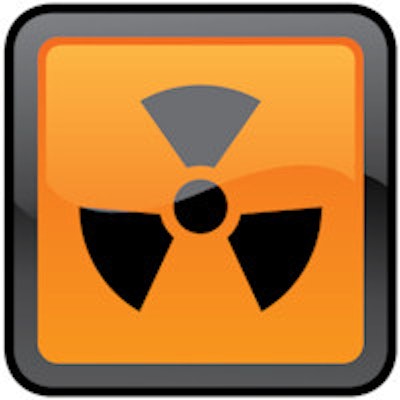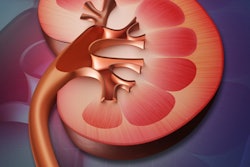
A group of researchers studying the use of CT for kidney stones were surprised by the radiation dose levels they discovered in their multicenter clinical study. Not only were many doses too high, they also varied widely between centers, concludes a research letter published June 29 in JAMA Internal Medicine.
The letter discusses a data analysis of the 15-center Study of Tomography of Nephrolithiasis Evaluation (STONE), which included more than 1,500 patients. The analysis revealed that CT exams in the trial had a median effective dose of 11 mSv -- when 4 mSv would have been fine.
Low-dose CT protocols were applied in fewer than 8% of cases, according to lead author Dr. Rebecca Smith-Bindman of the University of California, San Francisco (UCSF), who served as principal investigator of both the original STONE trial and the new analysis.
"I was actually quite surprised by the results ... we thought we'd see lower doses," Smith-Bindman told AuntMinnie.com in an interview.
The results could indicate that methods for reducing radiation dose that rely on voluntary participation by imaging facilities aren't working, and more centralized overnight is needed, she said.
Dose higher than accepted standards
Low-dose CT protocols of 4 mSv or less are widely accepted inasmuch as image and diagnostic quality are equivalent to standard-dose exams for ruling out suspected urolithiasis. Moreover, low-dose techniques reduce the risk of carcinogenesis, Smith-Bindman, Michelle Moghadassi, Dr. Richard Griffey, and colleagues wrote in the letter (JAMA IM, June 29, 2015). With current CT dose optimization tools, doses can be further reduced to 1 mSv or 2 mSv.
The analysis aimed to determine the CT radiation doses for a single indication in the STONE trial, which compared the effectiveness of CT with ultrasound in patients with suspected urolithiasis.
Patients were excluded from the study if they were obese or at high risk for a significant alternative diagnosis, the authors wrote.
The patients presented at one of 15 academic centers between October 2011 and February 2013. The researchers excluded scans with missing radiation dose information, and they stratified the dose data by patient factors and center and hospital characteristics, such as safety history, ownership, and emergency department patient volumes.
The radiation doses were carefully measured in a separate data coordination center, Smith-Bindman said.
Too many high-dose scans
The 1,582 patients were scanned at a median effective dose of 11 mSv (range, 0.34-73 mSv) and a median CT dose index volume (CTDIvol) of 14 mGy (range, 0.5-100 mGy), the researchers found.
Other results were as follows:
- Only 121 patients (7.6%) underwent imaging using low-dose techniques (defined as 4 mSv or less).
- There was a 200-fold variation in radiation dose between patients, and the dose varied fivefold between hospitals, from 4 mSv to 19 mSv.
- Hospital characteristics were not associated with dose level, nor were patient factors including education or level of risk of urolithiasis.
"Current doses are higher than needed ... and demand that we do something," Smith-Bindman told AuntMinnie.com.
Along with high dose levels, "we saw profound variation by hospital from [a median] 4 mSv to a high of 19 mSv -- a huge difference, and none of it was explained by patient risk factors for stones," she said.
Fortunately, at least, UCSF turned in the lowest overall doses levels, she added.
What happened?
The trial included elite institutions that used highly controlled data-collection methods and trained and certified readers and technologists, all while paying great levels of attention to how the CT scans were conducted. So why weren't radiation doses lower?
Smith-Bindman believes her major mistake in designing the study protocol for STONE was allowing readers to use their own local scanning protocols, she said.
"I'm disappointed in myself for not starting with the protocols" and controlling CT dose rigorously for the original trial, Smith-Bindman said.
In ruling out urolithiasis, low-dose CT is just as good as standard-dose scanning because of the high contrast of stone to underlying tissue, and "everyone knows that the [American College of Radiology] recommends low-dose CT in patients at high risk of kidney stones," she said.
A postanalysis meeting with the participating radiologists and technologists, organized to find out what happened, revealed many ways in which the process could have failed, Smith-Bindman said.
The clinician might order the wrong test; a technologist may lack access to a low-dose protocol, "which happened at several hospitals"; and a technologist might choose the wrong scan, such as a higher-dose routine abdomen/pelvis instead of a low-dose scan to rule out suspected urolithiasis, she said.
"We have this illusion where the technologist links the clinical indication to a scanner and matches it to a low-dose study," but it's not remotely true, at least not yet, Smith-Bindman said.
Strong data on current practice
In its favor, STONE examined a large series of patients with the single clinical indication of suspected urolithiasis. On the downside, it remains unknown how clearly the clinical indications were communicated to staff deciding on the CT dose, Smith-Bindman and colleagues wrote.
Most patients in the emergency department with suspected urolithiasis are not scanned with appropriate low-dose CT techniques, the study team concluded.
"Asking every facility to figure out what they need to do around dose without collecting data or having standards is not working, and suggests that some kind of standards or oversight is needed if we're hoping doses are going to come down," Smith-Bindman said.
"I think we need to put systems in place to make radiology safer, and I think some of our radiology leadership would prefer that we pretend there are no harms," she continued. "But we need to take the harms more seriously in order to improve the value of what we do."




















